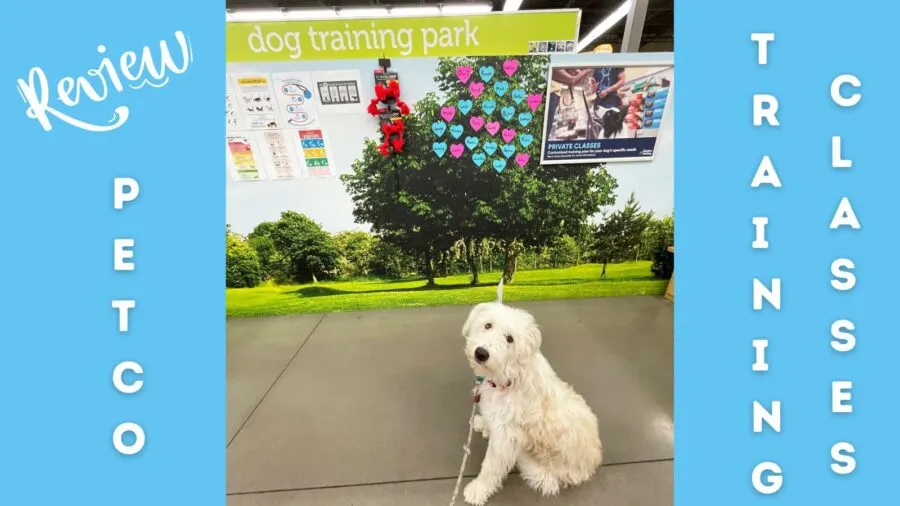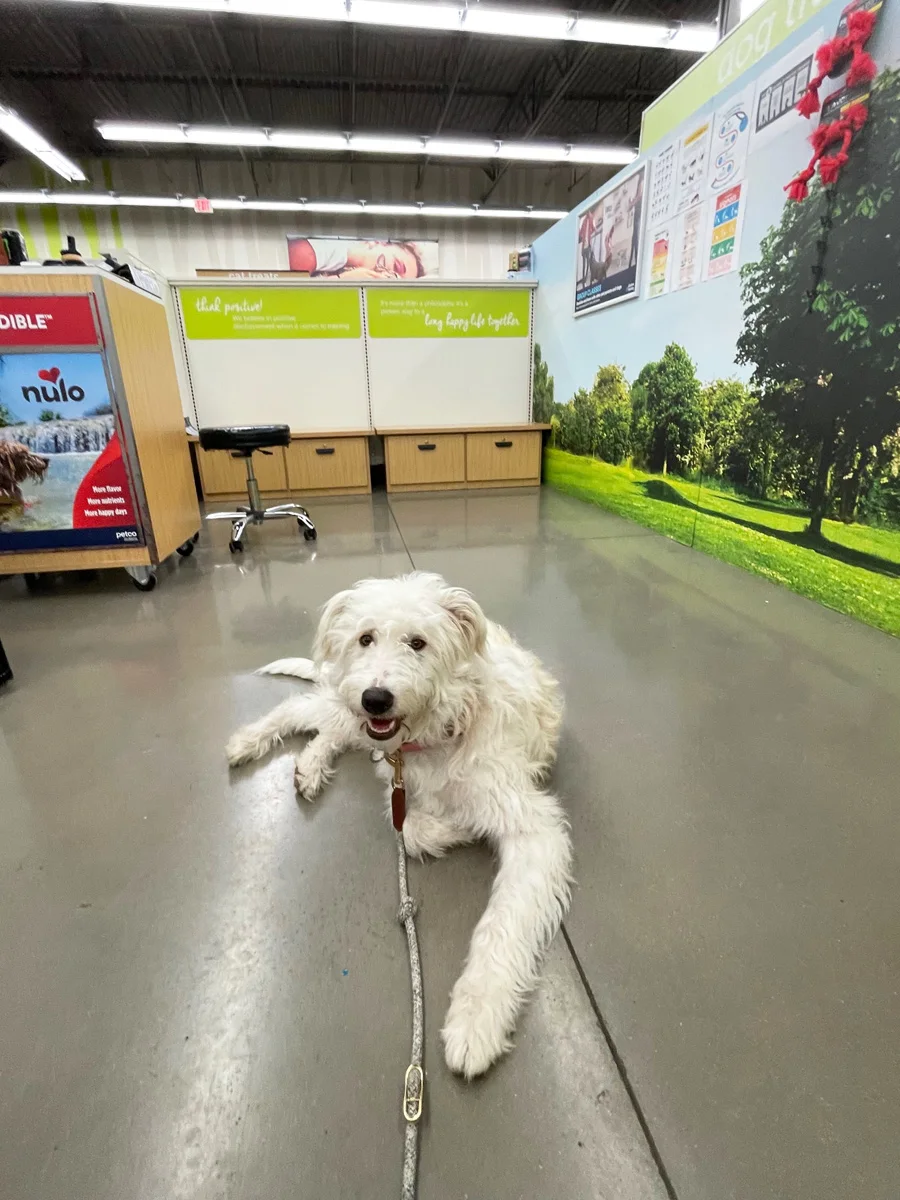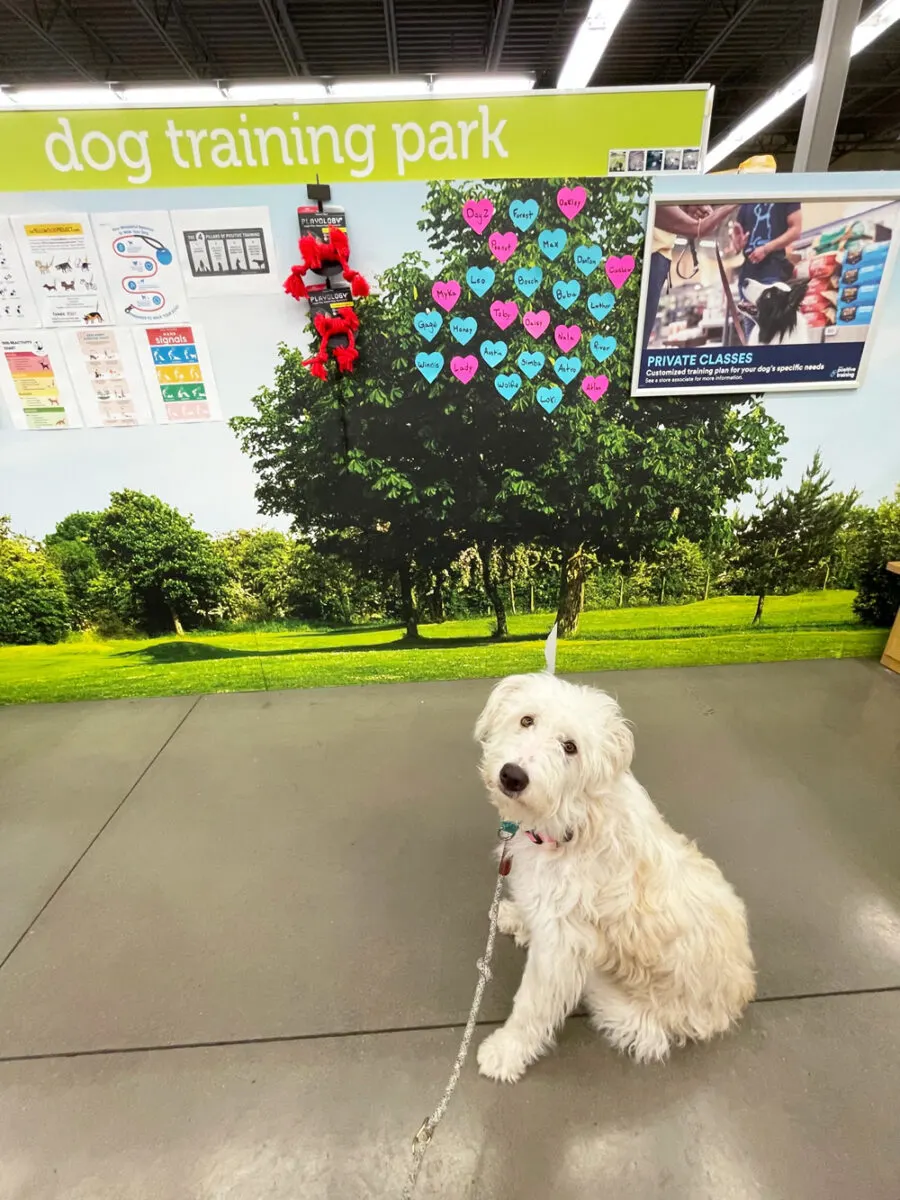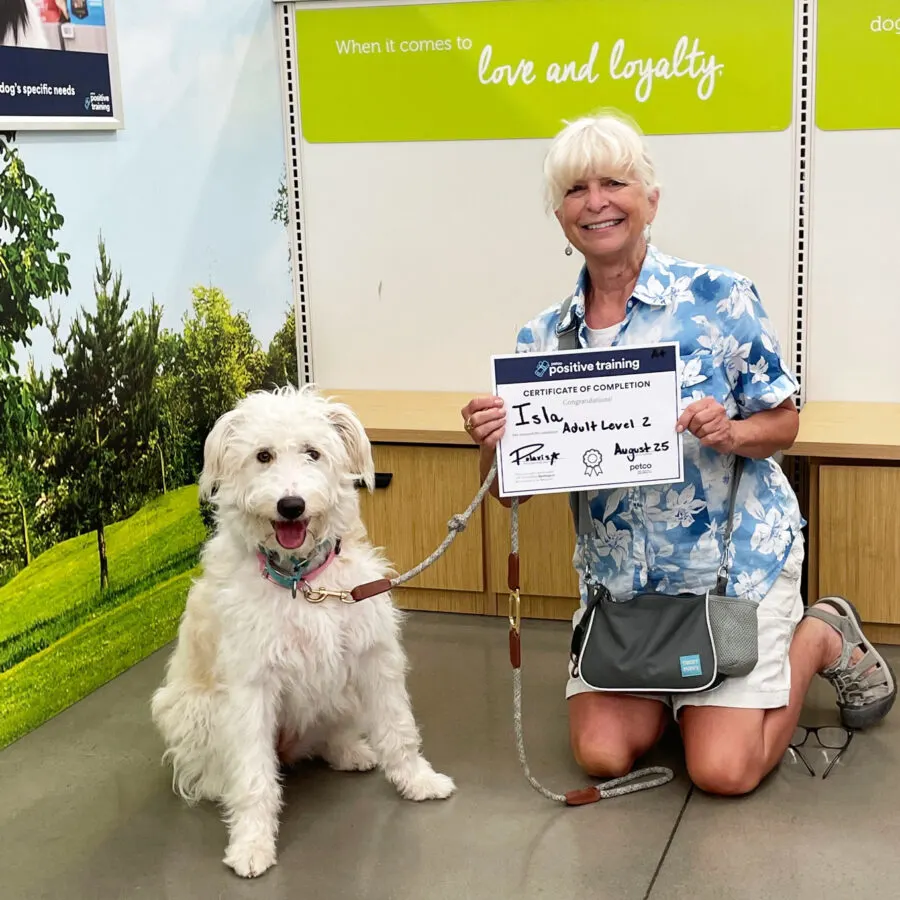Are you looking for a positive reinforcement dog training class near you? With over 1500 stores in the US and Mexico, Petco training classes are a convenient choice for many people. What should you know about these dog training classes before enrolling? We recently completed Petco’s adult classes so read on for our first-person review.

Which Petco Training Classes Are Offered for Adult Dogs?
Petco has an Adult I class (also called Fundamentals) for adult dogs or puppies over six months old. This class covers the basics: sit, down, stay, come, leave it and loose leash walking.
They then have an Adult II class (also called Advanced) which continues to work on those skills as well as Heel and walking with distractions.
You can buy the classes separately or purchase an AKC Complete Package which covers both the Adult classes as well as a Canine Good Citizen test. Currently the classes are priced at $149 for a six-week class or $249 for a package with two classes (12 weeks) and a test. (Watch for Petco’s frequent coupons, too.) You can enroll in classes online or at the store.
Petco also offers a separate Canine Good Citizen preparatory course.
Along with these group classes, Petco also offers private lessons and online dog training.
I signed our dog Isla up for an AKC Essentials Package for puppies which included two puppy classes and the AKC STAR Puppy test. She completed Puppy I but then our trainer suggested that she go ahead and skip to Adult II (we do a lot of training at home) so we moved on to Adult classes. Along the way, Isla took and passed her STAR Puppy test.
Where are Petco Training Classes Held?
Unlike some dog training facilities that hold classes in a dedicated facility or even outdoors, Petco classes are held in the store itself.

The training facility is generally carved out from the store by a movable wall which blocks the dogs’ view of the store–but doesn’t stop the sound of the activity in the store.
The noise of the store was a big plus for me. Since we live in the country and Isla doesn’t get much exposure to other people unless I specifically take her with me to a park or a store that welcomes dogs, I was looking for plenty of activity to help her learn to feel comfortable in busy situations. I even booked our classes for weekends instead of weekdays so the stores would be busier.
What are the Classes Like? Our Experience

With the fairly small facility within the store, classes are also small (although this varies from store to store). Our Adult II class had only two dogs (counting Isla!)
In the first class, you’ll need to show your dog’s immunization records. Be sure to bring those to the first class; your dog’s rabies tag is not enough!
You’ll also want to bring a fixed leash (not a retractable) no longer than six feet. Isla’s leash was six feet long but I knotted it a couple of times to make it a bit shorter.
As a positive reinforcement training center, you’ll need to use either a flat (or rolled) collar or a harness. Pinch collars and choke collars are not permitted. I use a Martingale collar out in the parking lot to make sure Isla can’t back out of her collar so when I got in the store each time I then just moved her leash over to her flat collar.
Once everyone’s checked in for the first class, you’ll then begin training within the confines of the training center. Classes are 50 minutes long (and they go by fast!)
As the classes progress, our training took place more and more in the store itself, first practicing loose leash walking and heeling. Later we progressed to working on a long line, a 20-foot line that let me put Isla into a sit at the end of an aisle, then walk to the other end of the aisle and call her to come.
From here, we moved on to working with distractions, ranging from the trainer rattling treats and squeaking toys on the next aisle to walking down the chews aisle (where bully sticks and horns were on offer in open-air bins) to practice heel and leave it.
The sixth class was a refresher of all the skills and a test of the commands out in the store on her regular leash.
And Isla passed! She got her certificate as well as a toy and a bag of treats:

What’s next for Isla? We are on to Canine Good Citizen classes soon at Petco!
What to Expect from Petco Trainers
At Petco, you can expect trainers who solely rely on positive reinforcement methods – a key factor in my decision to enroll Isla in their classes.
Although most trainers are not CPDT-KA certified, they have undergone comprehensive training through Petco’s science-based program. Moreover, all Petco trainers serve as AKC Canine Good Citizen evaluators, enabling you to take the Canine Good Citizen (CGC) test at the stores.
Darris Cooper, the National Manager of Pet Services Dog Training Education at Petco, stands out as a Certified Professional Dog Trainer Knowledge Assessed (CPDT-KA) and Fear-Free Animal Trainer.
While I trained Barli at a dog training facility with CPDT-KA trainers due to his shyness, I didn’t have the same concerns with Isla. I felt really good about all the Petco trainers I worked with in puppy and adult classes.
Pros and Cons of Petco Training Classes for Adult Dogs
Pros
Affordable: Petco offers training classes at a reasonable price. I was able to purchase a package (2 classes and an AKC test) for less than the cost of one class at a pricier training facility. This allows me to cover the basics with Isla at a low price, leaving room in my budget for more specialized classes in the future.
Personalized Attention: With typically only 2-4 dogs per class, you can expect more individualized attention from the trainer.
Increased Socialization: Conducting the classes in a store setting provides additional opportunities for your dog to socialize with other animals and people.
Flexible Schedule: Training classes are offered frequently, and with numerous Petco stores available, it’s likely that you’ll find one that fits your schedule.
Drawbacks
Small Class Size: Petco’s small class sizes limit the number of dogs and people that your pup can socialize with. If anyone in the class drops out, your dog is getting fewer exposures to people and pets.
Small Classroom: Additionally, the small teaching facility may restrict your dog’s ability to practice commands like come and may be overwhelming for overly excited dogs. The store tries to maintain a six-foot distance between dogs but this could be difficult in some stores with small training facilities. Training is easier once you’re able to get your dog out in the store to practice loose leash walking and other skills.
Store Noise: The noise and activity in the store could also be too distracting for easily distracted, nervous, shy, or overly excited dogs.
Trainers without Advanced Training: While we have had good luck, the quality of training can vary between stores. If you have serious behavioral concerns with your dog, we recommend finding a CPDT-KA accessed trainer.
More Articles You Might Like
Make 500 Homemade Dog Training Treats {In Just Minutes}
6 Ways to Use Training Treats Even When You’re Not Dog Training
- Review: Jimmy BX7 Pro Anti-Mite Vacuum Cleaner - December 16, 2024
- 🎉 GIVEAWAY: Lord of the Pets Portrait of Your Dog! - November 26, 2024
- Review: Lord of the Pets Portraits - November 17, 2024
